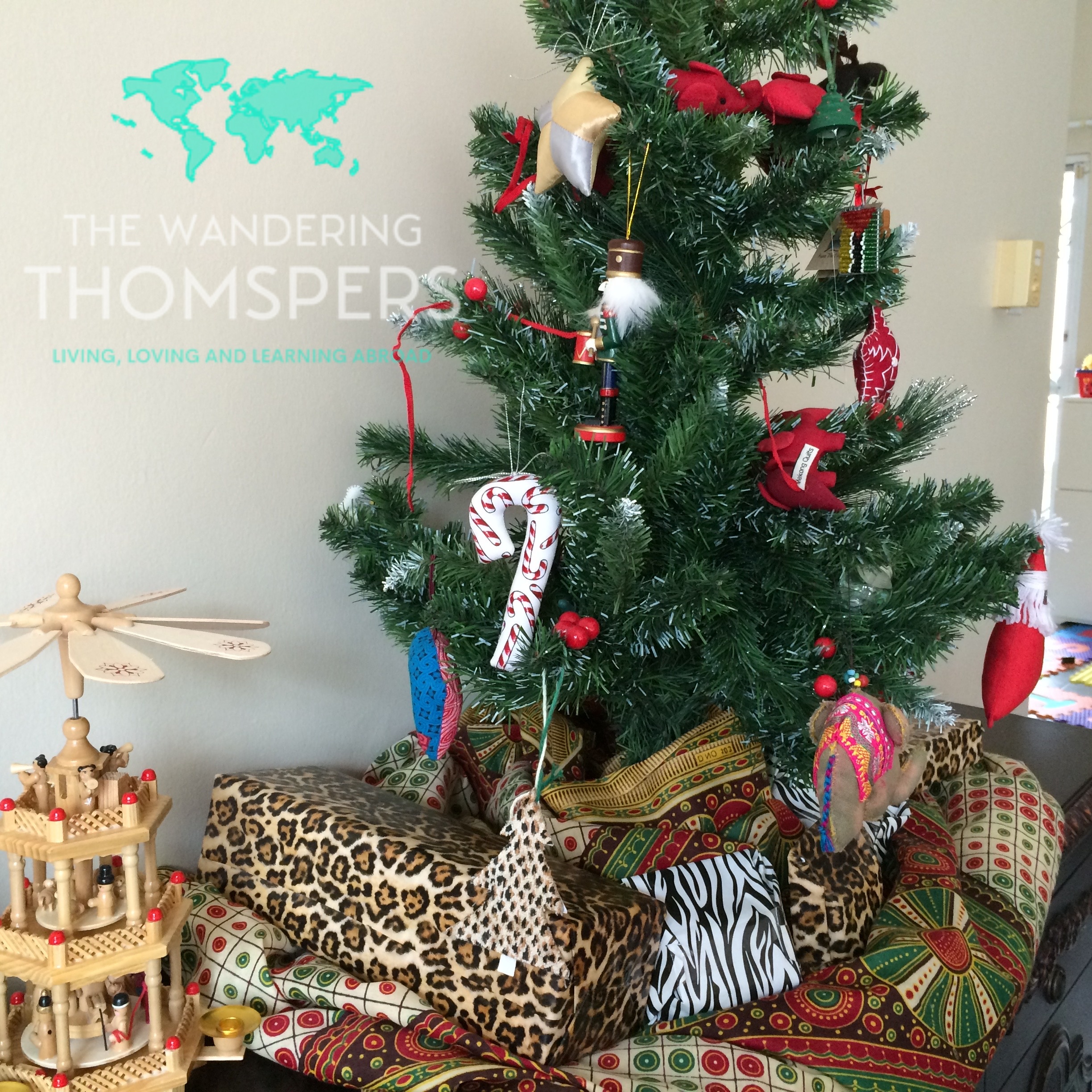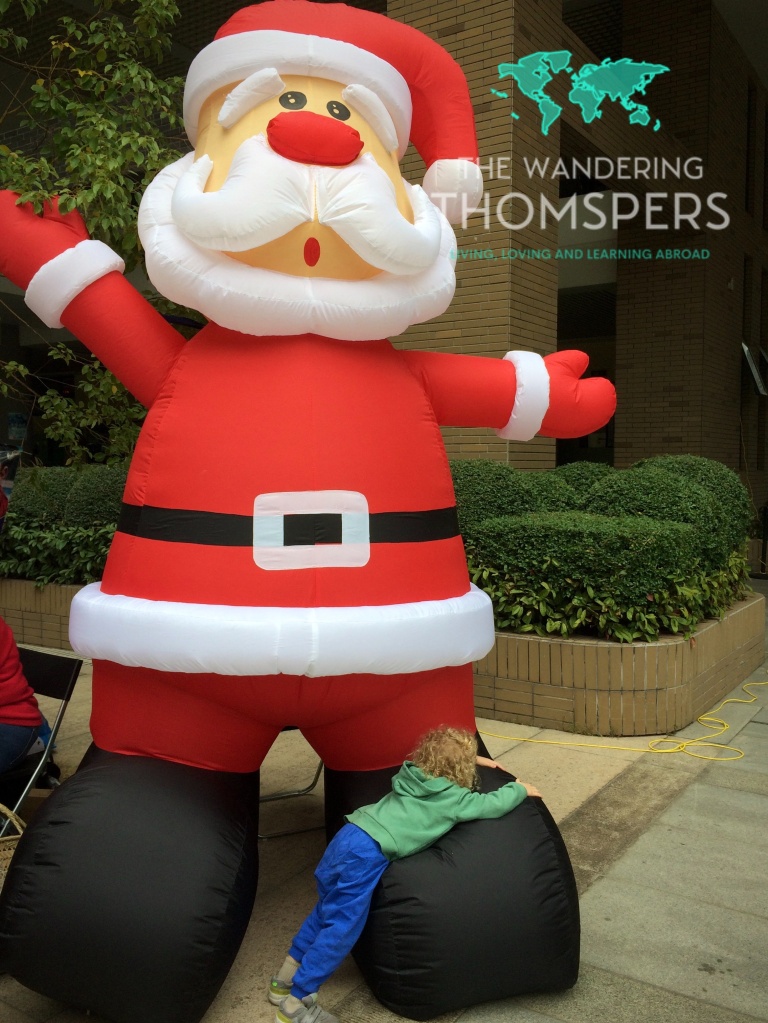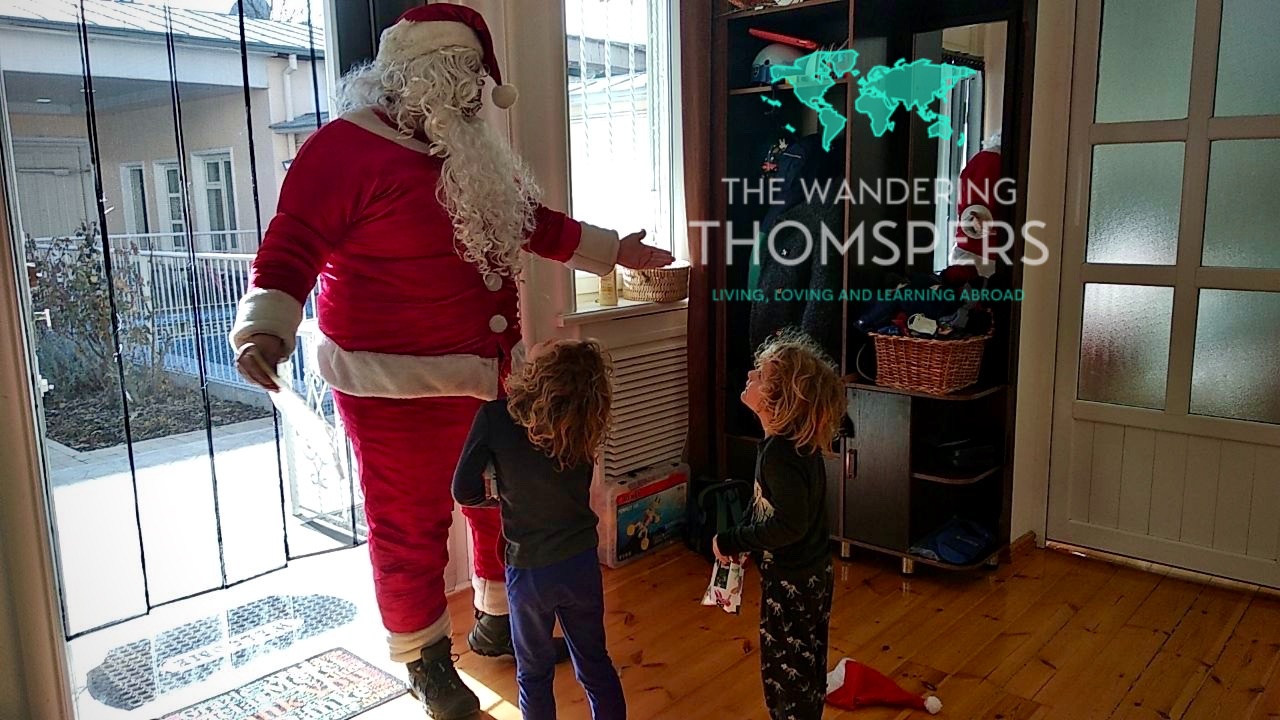Major holidays require significant motivation and carefully consideration when living abroad. Otherwise they will likely pass by unnoticed. The required intentionality is twofold. First, our children are third culture kids (TCKs) who have spent minimal time in their passport country and thus are not growing up immersed in the religious and cultural traditions that Brian and I draw on for memories and comfort. Even when Christmas is acknowledged in the country where we live, it is generally a novelty and doesn’t penetrate into every moment from Halloween to New Years. Without the insidious Christmas music, creepy shopping mall Santas or endless TV commercials pushing cheap plastic toys, holiday season for Bug and Noodle is mostly about slowing down, spending time together, eating delicious food, and going on adventures. Second, holidays can bridge connections with people who live in our current country of residence and deepening our understanding of their culture.



As single expats without children, Christmas once meant solo travel for Brian and trips home for me. Now, the financial hit of four long-haul tickets alongside the time-sucking 32 hours in transit (each way) and soul-crushing jetlag means limiting trips home to once a year for the longer summer break from school. The non-sympathy-stirring caveat is that we often live close to destinations that might be once-in-a-lifetime trips for others. However, given the pandemic and related quarantine requirements, international travel is out of the question this year. Being so far from home during such an emotional and turbulent time globally while actively adapting to a new culture might seem the perfect storm for homesickness, as happened to me last year. But the optimism of our most recent move and the desire to nest in our new home actually made this a very cozy and content Christmas.


Expat teachers usually hop on the first flight out of town the moment school finishes for the holiday break, as we are quite burnt out by mid-December and ready to rejuvenate on a beach or re-energize by plunging into a brand new culture. However, this year most colleagues chose to stay in Tashkent for obvious reasons, so none of us was suffering from expat envy while imagining the adventures of our friends and feeling left behind. Instead, we played tourist by skiing in the nearby mountains, checking out restaurants, and rummaging at antique and handicraft markets. Moreover, it was wonderful to get to know colleagues better without the stress of school looming over us. Highlights included making Christmas ornaments with the kids’ friends, tasting our first pavlova courtesy of our friend from New Zealand who joined us for Christmas Eve dinner, and ringing in the New Year at very small and carefully orchestrated gatherings.




Because the children have now reached an age of unbounded curiosity, some of their questions and our insights can give a bit of insight into our uniquely expat holiday. Here are the gems:
Why do we have a Christmas tree?
First, it’s actually not always a tree. Pine trees often don’t grow in most places we have lived (or they are imported and offer grave financial and climate destruction). Despite the guilt about buying plastic, we have bought and sold several fake trees; they just never seem to make the cut for taking up space in the shipment. In Mexico, we used a cactus. This year we could have done a different potted plant, but we just haven’t gotten to that point of household decor. So we settled for a hybrid plastic beauty that offers two types of needles as well as berries and pinecones. As a former tree guy, Brian believes it to be a cross-breed of holly, white pine and blue spruce. Bug and Noodle had a blast attaching the color-coded branches. And we were humored that the combination of tree, grand piano and formal dining room applied to our own lives.





Second, the branches offer a place to display all the decorations we have picked up throughout our travels. The process of unpacking and hanging ornaments creates a special tradition of recollecting memories. Additionally, Brian and I are darn near giddy as we wrap and arrange presents underneath said holiday plant on Christmas Eve because it sparks our inner child and gives us satisfaction that we have achieved some level of parenting success this year.

Who is Santa Claus? Will he know where we live? How is he going to get in our house?
We have wavered about our strategic approach to the Santa part of Christmas. Both Brian and I have fond memories of the magic and anticipation surrounding St. Nick. Neither harbors the horror story of shockingly discovering he wasn’t real. It was a gradual thing aided by loose-lipped older siblings. We never felt betrayed by our parents for intentionally lying to us. It was just fun. And once we found out the truth, it was still fun to pretend. But wow, there are some strong feelings about the subject. Especially since our parenting and teaching are so deeply committed to respecting and empowering children. Psychologists have written extensively about the harm that lying to children about Santa can cause. This is supported by educators and parents dedicated to the Montessori method, which believes that adults shouldn’t expose children under six to fantasy, including Santa, as it can cause a range of negative effects. Others remind us that honesty and the true spirit of Christmas can be nurtured. The approaches we connect to honor the spirit of Christmas and are shaped most by the children’s questions and play invitations…with a little sprinkling of pretend from us.

I am completely creeped out by the Foucauldian watchman vibe of a certain approach to Christmas that uses a spying elf or Santa to scare children into good behavior. Gift-giving in our house is inspired by generosity rather than anybody’s naughty or nice behavior. Moreover, Elf on the Shelf requires way to much effort at a time of year when us teacher-parents are drowning in end-of-the-year professional responsibilities.


A dad we know offered to stop by our home dressed as Santa on Christmas Eve Day, and Brian and I wavered. Would it frighten the kids? Or take the lie a tad too far? We decided to accept the offer and see what happened. Although Bug and Noodle quickly realized that it was their friend’s dad, the squealed and reveled in the excitement. Obviously they left the Big Guy a plate of cookies before bed because that was our caloric reward for nudging them through the authentic literacy experience of writing him a letter. And the next morning, Santa’s name appeared on several presents under our tree – but definitely not the best ones because Mom and Dad are taking credit for that – and Bug proudly decoded the gift tags with he new phonics skills. When the children asked if Santa was real, we responded with our favorite teacher question: “What do you think?” And let them lead the way.


Why is Santa in Uzbekistan blue? Who is that lady with Santa?
Uzbekistan is a crossroads in so many ways, and holidays prove not an exception. We noticed that December brought modest holiday light decorations and tree displays that were familiar to our American frame of reference. But the Santa figure was skinny and dressed in blue, and his only companion was a beautiful young woman in a wintry princess costume. After questioning our local friends and a peek at Wikipedia, we learned that the man is not Santa Claus or Saint Nick, but Grandfather Frost or Ded Moroz (Дед Мороз). He made his way to modern day Uzbekistan via pagan Slavic mythology that influenced Soviet culture. He is similarly kind and delivers toys to children. However, diverging from our lore, the supporting character here is his granddaughter, Snegurochka (Снегурочка) rather than Mrs Claus or elves. And horses pull his sleigh instead of flying reindeer.
Due to the secularity of communism, Ded Moroz was temporarily banned in the late 1920s but eventually brought back. However, he was then reassigned to stand in front of the now called New Years Trees and bring presents on January 1 instead of Christmas Day. It should be added that Russian Orthodox Christianity celebrates Christmas on January 7 or 8 following the Julian calendar rather than on December 25 for sects of Christianity following the Gregorian calendar, not that the technicality has much religious implication since biblical scholars agree that Jesus was not actually born in the winter.

Who is Jesus? Why are we celebrating his birthday?
Well, Brian and I are a bit loose in our religious discussions with the kids. We grew up going to varying intensities of Sunday school and got the gist of Christianity, but neither of us identifies strongly with the faith today. We talk to the children about God (as he or she). They know that the mosques, temples and churches they’ve visited are special places to pray. We describe praying as mindfulness and listening to our hearts. Things that we emphasis as sacred are family, kindness, acceptance of others and ourselves, and nature. Jesus fits well into this view. Bug and Noodle know he was a wonderful man who was kind and generous and loving to all. The one slightly religious tradition for our Christmas is cuddling up and watching the movie, The Star, which is a very child-friendly depiction of Jesus’ birth.



Admittedly, this was not our best year for strongly emphasizing the giving part of Christmas. We did take each child shopping separately to choose gifts for the rest of the family. Also, they selected items to donate to our school’s charity drive for local children in need (and we involve them in events throughout the year). However, now that we are more settled in UZ and the children are at ages where they can more independently participate in many tasks, we are keen to weave empathy and charity into our family traditions not just at Christmas but throughout the year.


What a wonderful message! I’m SO impressed that you write and illustrate these posts so, so well. They’re a true pleasure to read, even when the material might not be as newsy to me as it is to others on your mailing list. It’s the insight and thoughtfulness that always strikes me the most. Keep these coming! Dad
LikeLiked by 1 person